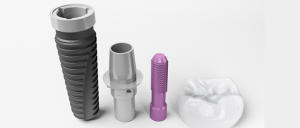 Dental implants that are widely in use today were invented in the 19th century. Today, they are considered as the standard prosthetic replacement of missing teeth in dentistry. The dental implant that acts as the replacement for the lost teeth is fixed into the jawbone, which fuses with the bone over time. The artificial tooth root holds the replacement teeth or bridge. As the dental implant stands without any support and has excellent stability, these are considered to mimic the natural teeth.
Dental implants that are widely in use today were invented in the 19th century. Today, they are considered as the standard prosthetic replacement of missing teeth in dentistry. The dental implant that acts as the replacement for the lost teeth is fixed into the jawbone, which fuses with the bone over time. The artificial tooth root holds the replacement teeth or bridge. As the dental implant stands without any support and has excellent stability, these are considered to mimic the natural teeth.
What Are Dental Implants?
The dental implants are usually made of titanium which has the ability to fuse into the bone without being rejected by the immune system. These implants fuse to the jawbone through a process called Osseointegration. Over time, technology has advanced and significantly improved the dental implants success rate close to 98%.
When Is A Dental Implant Needed?
Dental implants are used as the replacement of single teeth or several teeth or all the teeth. You have three options when it comes to teeth replacements. They are complete or partial dentures, fixed dental bridges, and dental implants.
Dentures are the most affordable option among the three but are least desired because of their inconvenience as they are removable. It also affects tastes and sensory experience of food. Dental bridges were much used before dental implants came into play, but it had a significant disadvantage of dependence on the adjacent natural tooth for support. But implants are anchored to bones and do not require any additional support.
Deciding On Which Treatment To Choose Depends On Several Factors Such As:
- Location of the missing teeth
- Cost
- Patient preference
- Quality of the jawbone
The dentists examine the patient and assess whether he is a good candidate for dental implants and discuss dental implants cost with them. As the dental implants integrate with the bone, they are more stable and look and feel like natural teeth.
Types Of Dental Implants:
There are two types of implants, the endosteal and subperiosteal implants. Endosteal implants are implanted directly into the jawbone. After the surrounding gum tissues cure, the artificial tooth or teeth are fixed to the post individually. Subperiosteal implants consist of metal frames that rest on top of the jawbone under the gum. However subperiosteal implants are not in practice now because of their poor long-term results.
There are some secondary uses of implants to assist other dental procedures. Due to their stability, they can be used to support removable dentures providing a more comfortable and secure fit. Besides, dental mini implants can be used in orthodontics as temporary anchorage devices to help move teeth in the desired position.
Cost Of Dental Implants:
In Sydney, dental implants costs may vary with the location of the missing tooth and its severity. As dental implants offer a conservative approach, provide predictable results and last a lifetime, the money invested worth it.


